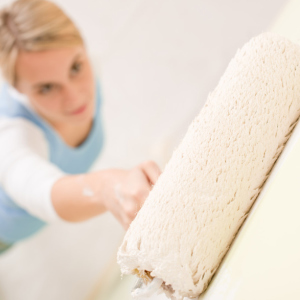The main requirement for the preparation of the surface under painting is a flawlessly smooth surface. Many surfaces are unsuitable for applying paint, these include drywall sheets and cement-sand plaster. In this case, it is resorted to spatlement of walls with starting and finishing solutions.
Preparation of the surface of the walls under painting provides for compulsory alignment and putty, to achieve the maximum smooth surface, also in certain cases resort to grinding and processing with special busting solutions. Methods and methods for aligning the surface of the walls depend on the initial state of their:- If the walls are strongly uneven, then it is important to correctly install the profile and attaching the plasterboard so that all the sheets are in the same plane within one wall.
- If the walls have small recesses, you attach the necessary thickness to the wall of the lighthouses (use wooden or metal rails as a lighthouse).
- If the errors are small, then pass the surface with a special grinding machine or a conventional abrasive grid.
- If the walls are aligned with drywall sheets, then apply a small layer of putty on all joints and corners, laid the mounting tape.
- If the method is used for alignment, then in places between the beacons, overlay the layer of plaster or starting putty and lead the spatula on the adjacent lighthouses, thereby moving the plaster, after the solution freeze, remove the beacons, the holes left after the beacon, fill the same solution.
- If the surface was previously painted, then clean it from the old coating with a grinding tool or sandpaper, cover with antiseptic solution, wait for it to complete drying, apply a primer mixture.

- the solution should be homogeneous;
- apply a mixture on a wide spatula along its entire length, using narrow;
- having attached it to the wall at an angle of 60 °, stretching before the putty will stop molding to the wall;
- remove the putty-remaining putty and clean spatula to the surface;
- wash the spatula every time from another type of putty or if the solution is reduced;
- the frozen strips from the side edge of the spatula can be confused by a narrow spatula or abrasive grid, not allowing recesses;
- sollar apply medium or large portions;
- check the shortcoming test: highlight the lamp at a slam angle to the wall, where the shading will be - apply the finish putty again or polish;
- before applying each layer, get rid of the surface from dust with a dry cloth or vacuum cleaner;
- it is necessary to putty in the direction in which irregularities go.
For spittle, you can use both ready-made mixtures and dry, which should be dissolved in accordance with the instructions.



































